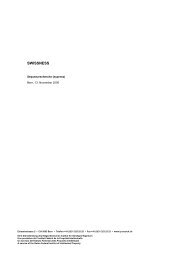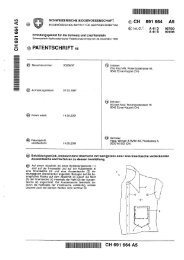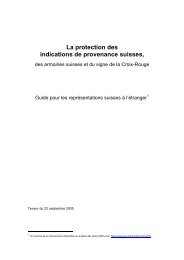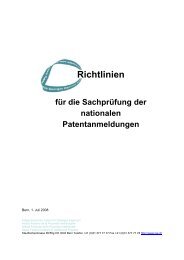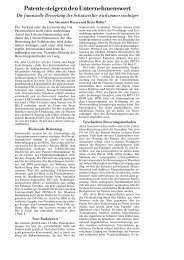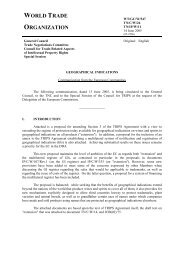AVIS DE DROIT PROTECTION DES SIGNES NATIONAUX
AVIS DE DROIT PROTECTION DES SIGNES NATIONAUX
AVIS DE DROIT PROTECTION DES SIGNES NATIONAUX
Create successful ePaper yourself
Turn your PDF publications into a flip-book with our unique Google optimized e-Paper software.
ETATS-UNIS<br />
particularized message was present, and whether the likelihood was great that the message<br />
would be understood by those who viewed it.” 323 If so, we must then ask whether the<br />
governmental regulation (on a state or federal level) of the conduct is related to the<br />
suppression of expression or if the governmental interest to be protected by the statute was<br />
unrelated to the suppression of free expression. If the statute were of the former type, it<br />
would be subject to strict scrutiny. If the statute were of the latter type, the government<br />
would need only show that it furthers an important or substantial governmental interest, and<br />
that the restriction of First Amendment rights is no greater that is essential to the furtherance<br />
of that interest. 324<br />
Any governmental regulation concerning the use and treatment of the flag, then, may have<br />
Constitutional repercussions. In addition to the applicable legislation, there is a substantial<br />
amount of case law (much of which surrounding flag burning as a form of political protest<br />
against the war in Vietnam) concerning the issue. 325<br />
The Flag Code<br />
Either Congress or a state legislature may, under the police power granted by the Constitution,<br />
prohibit or regulate the use of the national flag of the United States. 326 The power to<br />
reasonably regulate usage and display of the flag does not, however, entitle the government to<br />
appropriate the colors red, white and blue and the depiction of stars and stripes. 327 Contentneutral<br />
time, place and manner flag statutes or ordinances which advance substantial<br />
government interests are valid. 328 Federal statutory provisions cover the design of the United<br />
States flag, as well as its display and use. 329<br />
Congress adopted the Flag Code, a guide for all handling and display of the Stars and Stripes,<br />
in 1942. The Federal Flag Code, however, is merely advisory and is not intended to proscribe<br />
conduct. 330 With the exception of 4 U.S.C. § 3, it does not impose penalties for misuse of the<br />
United States Flag. That is left to the states and to the federal government for the District of<br />
Columbia. 331<br />
The Flag Code provides that the flag should not be used as wearing apparel, bedding or<br />
covering for a ceiling, for advertising purposes in any manner whatsoever, nor should<br />
advertising signs be attached to a staff or halyard from which the flag is flown. Similarly a<br />
flag should not be embroidered on a cushion or printed on paper products nor should any part<br />
of the flag be used as a costume or athletic uniform. A flag patch may, however, be affixed to<br />
323<br />
Texas v. Johnson, 491 U.S. 397, at 405, (1989).<br />
324<br />
See United States v. O’Brian, 391 U.S. 367, 377 (1968).<br />
325<br />
See, e.g. Texas v. Johnson 491 U.S. 397 (1989), United States v. Eichman, 496 U.S. 310 (1990).<br />
326<br />
Halter v. State of Nebraska, 205 U.S. 34 (1907).<br />
327<br />
Parker v. Morgan, 322 F. Supp. 585 (W.D.N.C. 1971).<br />
328 th<br />
American Legion Post 7 of Durham, N.C. v. City of Durham, 239 F.3d 601 (4 Cir. 2001) as cited in<br />
36A C.J.S. Flags §3.<br />
329<br />
4 U.S.C. §§ 1-10 available at:<br />
http://www.ushistory.org/betsy/flagetiq.html#5.<br />
See also http://www.suvcw.org/flag.htm.<br />
330 th<br />
Dimmitt v. City of Clearwater, 985 F.2d 1565 (11 Cir. 1993).<br />
331 See “droit regional”, infra.<br />
206



